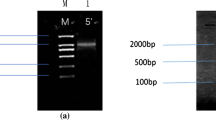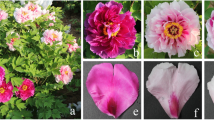Abstract
Herbaceous peony (Paeonia lactiflora Pall.) is an important ornamental plant that has different flower types. However, the molecular mechanism underlying its floral organ development has not been fully investigated. This study isolated six floral organ development-related genes in P. lactiflora, namely, APETALA1 (PlAP1), APETALA2 (PlAP2), APETALA3-1 (PlAP3-1), APETALA3-2 (PlAP3-2), PISTILLATA (PlPI) and SEPALLATA3 (PlSEP3). The expression patterns of these genes were also investigated in the three cultivars ‘Hangshao’, ‘Xiangyangqihua’ and ‘Dafugui’. Furthermore, gene expression during floral development was also analyzed in different organs. The results showed that PlAP1 was mainly expressed in the sepals, and PlAP2 was mainly expressed in the carpels and sepals. PlAP3-2 and PlPI had the highest expression levels in the stamens, followed by the petals. The expression levels of PlAP3-1 (from highest to lowest) were in the following order: petals, stamens, carpels and sepals. PlSEP3 was mainly expressed in sepals and carpels. With the depth of stamen petaloidy, the expression levels of PlAP1, PlAP2 and PlSEP3 increased, whereas those of PlAP3-1, PlAP3-2 and PlPI decreased, which showed that PlAP1 mainly determined sepals and petals of P. lactiflora. The PlAP2 not only determined the sepals and petals, and it participated in carpel formation. PlAP3-1, PlAP3-2 and PlPI mainly determined stamens and petals. PlSEP3 determined the identities of sepals and petals. This study would help determine the molecular mechanism underlying floral organ development in P. lactiflora.





Similar content being viewed by others
References
Wang JG, Zhang ZS (2005) Chinese herbaceous peony Beijing. China Forestry Publishing, Beijing
Zhao HJ, Zhang WT (1999) Classification and causes of flower type in herbaceous peony. North Hortic 5:26–27
Zhao YQ, Liu QL (2009) Research of forming mechanism and genetic characteristic in double flower. Acta Bot Boreali-Occident Sin 29(4):0832–0841
Zeng Y, Hu JY, Li ZJ (2001) MADS-box genes in the evolution of flower development. Plant Physiol Commun 37(4):281–287
Coen ES, Meyerowitz EM (1991) The war of the whorls: genetic interactions controlling flower development. Nature 353:31–37
Bowman JL, Smyth DR, Meyerowitz EM (1991) Genetic interactions among floral homeotic genes of Arabidopsis. Development 112(1):1–20
Angenent GC, Franken J, Busscher M, Dijken AV, Went JV, Dons HM, Tunen AV (1995) A novel class of MADS box genes is involved in ovule development in Petunia. Plant Cel1 7:1569–1582
Colombo L, Franken J, Koetje E, Went JV, Dons HJ, Angenent GC, van Tunen AJ (1995) The petunia MADS box gene FBP11 determines ovule identity. Plant Cell 7(11):1859–1868
Pelaz S, Ditta GS, Baumann E, Wisman E, Yanofsky MF (2000) B and C floral organ identity functions require SEPALLATA MADS-box genes. Nature 405:200–203
Pelaz S, Gustafson-Brown C, Kohalmi SE, Crosby WL, Yanofsky MF (2001) APETALA1 and SEPALLATA3 interact to promote flower development. Plant J 26:385–394
Jofuku KD, Boer BG, Montagu MV, Okamuro JK (1994) Control of Arabidopsis flower and seed development by the homeotic gene APETALA2. Plant Cell 6(9):1211–1225
Qin QP, Yi T, Chen JW, Xie M, Zhang SL (2006) APETALA3/DEFICIENS and PISTILLATA/GLOBOSA in evolution of flower development. Chin J Cell Biol 28:571–576
Yanofsky MF, Ma H, Bowman JL, Drews GN, Feldmann KA, Meyerowitz EM (1990) The protein encoded by the Arabidopsis homeotic gene agamous resembles transcription factors. Nature 346:35–39
Ditta G, Pinyopich A, Robles P, Pelaz S, Yanofsky MF (2004) The SEP4 gene of Arabidopsis thaliana functions in floral organ and meristem identity. Curr Biol 14:1935–1940
Honma T, Goto K (2001) Complexes of MADS-box proteins are sufficient to convert leaves into floral organs. Nature 4:525–529
Peña L, Martín-Trillo M, Juárez J, Pina JA, Navarro L, Martínez-Zapater JM (2001) Constitutive expression of Arabidopsis LEAFY or APETALA1 genes in citrus reduces their generation time. Nat Biotechnol 19:263–267
Lü JH, Wu YL, Sun L, Zhang QX (2007) Genetic transformation of Chrysanthemum morifolium cv. ‘Yu Ren Mian’ with AP1 gene mediated by Agrobacterium tumefaciens. Scientia Silvae Sinicae 43(9):128–132
Lin RM, Zhao WS, Meng XB, Peng YL (2007) Molecular cloning and characterization of a rice gene encoding AP2/EREBP-type transcription factor and its expression in response to infection with blast fungus and abiotic stresses. Physiol Mol Plant Pathol 70:60–68
Guo B (2006) Cloning and characterization of B function MADS-box genes involved in floral development from Phalaenopsis Orchid. Fudan University, Shanghai
Parcy F, Bomblies K, Weigel D (2002) Interaction of LEAFY, AGAMOUS and TERMINAL FLOWER1 in maintaining floral meristem identity in Arabidopsis. Development 129:2519–2527
Jack T (2004) Molecular and genetic mechanisms of floral control. Plant Cell 16:S1–S17
Zhao D, Zhou C, Kong F, Tao J (2011) Cloning of phytoene desaturase and expression analysis of carotenogenic genes in persimmon (Diospyros kaki L.) fruits. Mol Biol Rep 38:3935–3943
Schmittgen TD, Livak KJ (2008) Analyzing real-time PCR data by the comparative CT method. Nat Protoc 36(6):1101–1108
Zhang J, Xu GX, XueHY HuJ (2007) The formation and research progress of plant evolutionary developmental biology. Chin Bull Bot 24(1):1–30
Kyozuka J, Kobayashi T, Morita M, Shimamoto K (2000) Spatially and temporally regulated expression of rice MADS-box genes with similarity to Arabidopsis class A, B and C genes. Plant Cell Physiol 41(6):710–718
Liu ZX, Wang Y, Lv XM, Lu H, Li FL (2010) Cloning and expression analysis of floral organ identity gene in Prunus lannesiana. Acta Hortic Sin 37(4):649–654
Kim S, Koh J, Ma H, Hu Y, Endress PK, Hauser BA, Buzgo M, Soltis PS, Soltis DE (2005) Sequence and expression studies of A-, B-, and E-class MADS-box homologues in Eupomatia (Eupomatiaceae): support for the bracteate origin of the calyptra. Int J Plant Sci 166:185–198
Zhang L, Xu Y, Ma RC (2008) Molecular cloning, identification, and chromosomal localization of two MADS box genes in peach (Prunus persica). J Genet Genomics 35:365–372
Ren L (2011) Cloning and expression of floral organ development related genes in Paeonia suffruticosa. Chinese Academy of Forestry, Beijing
Chi YJ, Huang F, Liu HC, Yang SP, Yu DY (2011) An APETALA1-like gene of soybean regulates flowering time and specifies floral organs. J Plant Physiol 168:2251–2259
Zhou SM, Su YH, Wang L, Zhang XS, Shu H (2006) Cloning and transformation of apetala2 homologues genes from apple. Acta Hortic Sin 33(2):239–243
Athanasios ST, Konstantinos P, Panagiotis M, Anagnostis A (2012) Sequence characterization and expression analysis of three APETALA2-like genes from saffron crocus. Plant Mol Biol Rep 30:443–452
Luo HL, Chen SM, Jiang JF, Teng NJ, Chen Y, Chen FD (2012) The AP2-like gene NsAP2 from water lily is involved in floral organogenesis and plant height. J Plant Physiol 169:992–998
Klucher KM, Chow H, Reiser L, Fischer RL (1996) The AINTEGUMENTA gene of Arabidopsis required for ovule and female gametophyte development is related to the floral homeotic gene APETALA2. Plant Cell 8(2):137–153
Zhao Q, Wang T, Wei XD (2005) Function of AP2 gene during floral organs development in higher plant: review. Chin J Trop Agric 259(3):50–56
Ripoll JJ, Roeder AHK, Ditta GS, Yanofsky MF (2011) A novel role for the floral homeotic gene APETALA2 during Arabidopsis fruit development. Development 138:5167–5176
Zhou L, Zhou YT, Wang ML, Wang HY, Zhao Y (2010) Expressions and dimerization affinities of three highly identical APETALA3 genes in Brassica napus. Biol Plant 54(1):33–40
Tanaka Y, Yamamura T, Terakawa T (2011) Identification and expression analysis of the Cyclamen persicum MADS-box gene family. Plant Biotechnol 28:167–172
Broholm SK, Pöllänen E, Ruokolainen S, Tähtiharju S, Kotilainen M, Albert VA, Elomaa P, Teeri TH (2010) Functional characterization of B-class MADS-box transcription factors in Gerbera hybrida. J Exp Bot 61(1):75–85
Zhang YF (2010) Genetic and molecular mechanism of two stamen carpelloid male sterile lines of Brassica and the keylocus of AP3 gene to relevant to petal development. North West Agricultural and Forestry University, Xi’an
Poupin MJ, Federici F, Medina C, Matus JT, Timmermann T, Arce-Johnson P (2007) Isolation of the three grape sub-lineages of B-class MADS-box TM6, PISTILLATA and APETALA3 genes which are differentially expressed during flower and fruit development. Gene 404(12):10–24
Tsaftaris A, Pasentsis K, Makris A, Darzentas N, Polidoros A, Kalivas A, Argiriou A (2011) The study of the E-class SEPALLATA3-like MADS-box genes in wild-type and mutant flowers of cultivated saffron crocus (Crocus sativus L.) and its putative progenitors. J Plant Physiol 168:1675–1684
Tani E, Polidoros AN, Flemetakis E, Stedel C, Kalloniati C, Demetriou K, Katinakis P, Tsaftaris AS (2009) Characterization and expression analysis of AGAMOUS-like, SEEDSTICK-like and SEPALLATA-like MADS-box genes in peach (Prunus persica) fruit. Plant Physiol Biochem 47:690–700
Shan HY (2006) A study on structure, function and evolution of the MADS-box genes involved in floral development in Akebia Trifoliata. Graduate School of Chinese Academy of Sciences, Beijing
Wang YQ (2005) Study of MADS-box genes in rice and Taihanggia & The bioinformatic analysis of SAGE in rice. Graduate School of Chinese Academy of Sciences, Beijing
Uimari A, Kotilainen M, Elomaa P, Yu DY, Albert VA, Teeri TH (2004) Integration of reproductive meristem fates by a SEPALLATA-like MADS-box gene. PNAS 101(44):1582–15817
Acknowledgments
This study was financially supported by Agricultural Science & Technology Independent Innovation Fund of Jiangsu Province (CX(12)2019) and a project funded by the Priority Academic Program Development of Jiangsu Higher Education Institutions.
Author information
Authors and Affiliations
Corresponding author
Additional information
Jintao Ge and Daqiu Zhao contributed equally to this work.
Rights and permissions
About this article
Cite this article
Ge, J., Zhao, D., Han, C. et al. Cloning and expression of floral organ development-related genes in herbaceous peony (Paeonia lactiflora Pall.). Mol Biol Rep 41, 6493–6503 (2014). https://doi.org/10.1007/s11033-014-3532-8
Received:
Accepted:
Published:
Issue Date:
DOI: https://doi.org/10.1007/s11033-014-3532-8




